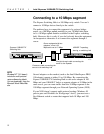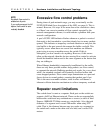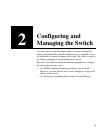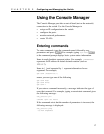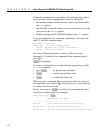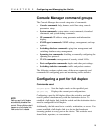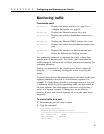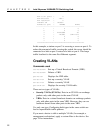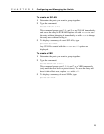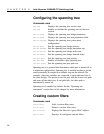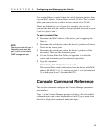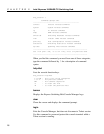
19
Configuring and Managing the Switch
CHAPTER 2
Console Manager command groups
The Console Manager has several categories of commands:
• Console commands: help, banner, serial line setup, console
parameters setup.
• System commands: system status, reset commands, download
commands, and system debug commands.
• IP commands: IP address setup, parameter and information
display.
• SNMP agent commands: SNMP settings, management, and trap
options.
• Switching database commands: aging time management and
switching database entry management.
• Spanning tree commands: disabling or manually configuring the
spanning tree protocol.
• VLAN commands: management of security virtual LANs.
• Port configuration commands: duplex and other port settings.
• Switching statistics commands: traffic and packet counters.
The following sections explain some of the more commonly used
commands for configuring ports and monitoring traffic statistics.
Configuring a port for full duplex
Commands used
set-port-dplex
Sets the duplex mode on the specified port.
get-port-cfg
Displays the current port configurations.
Configuring a port for full duplex allows the switch to send and
receive packets simultaneously with the destination device. To
establish a full-duplex link, both the switch and the destination device
must be configured for full duplex.
Additionally, the link must be to a switch, workstation, or server. You
cannot establish a full-duplex link to a device that broadcasts
incoming packets to every port on the device. This excludes most
shared hubs, repeaters, or concentrators.
NOTE
Setting a port to full duplex
automatically disables flow
control. Since collisions don’t
happen on a full-duplex link,
flow control isn’t needed.




